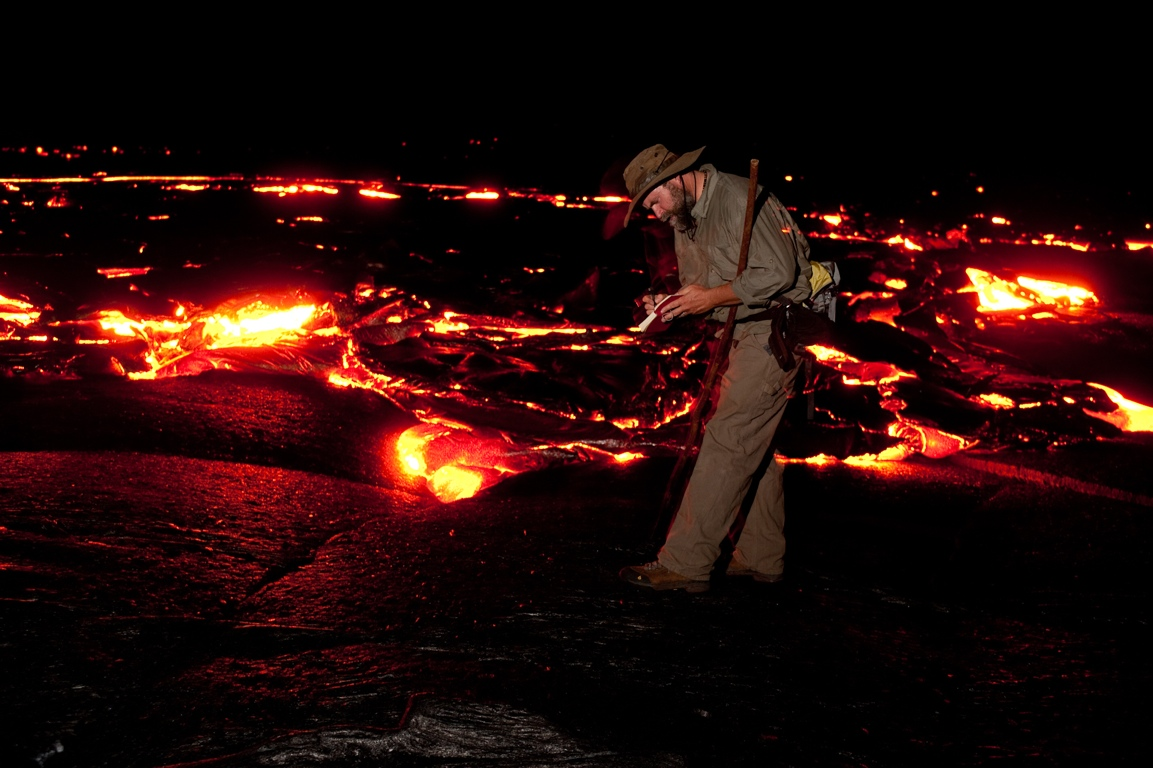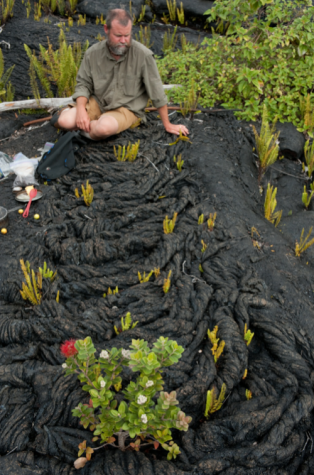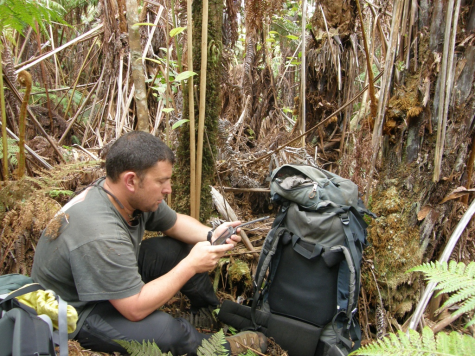 In 2014 I wrote about backpacking through live lava flows in Hawaii. The experience was remarkable, and the man who showed us the way has since watched his own house burn, its remnants consumed by molten rock, something he said he thoroughly enjoyed. On that journey, I threw a penny into live lava, expecting it to melt like the ring in the fires Mordor, but instead it pinged against a bright, liquid bulb and bounced off. That’s when I realized what we were dealing with, not an easy liquid like water, but molten metal. Here is my report from that trip, moving from the hot interior of the earth to what comes after…
In 2014 I wrote about backpacking through live lava flows in Hawaii. The experience was remarkable, and the man who showed us the way has since watched his own house burn, its remnants consumed by molten rock, something he said he thoroughly enjoyed. On that journey, I threw a penny into live lava, expecting it to melt like the ring in the fires Mordor, but instead it pinged against a bright, liquid bulb and bounced off. That’s when I realized what we were dealing with, not an easy liquid like water, but molten metal. Here is my report from that trip, moving from the hot interior of the earth to what comes after…
On Monday, a slowly-creeping lava flow claimed its first house on the Big Island of Hawaii. The iron-heavy pahoehoe flow crossed the house’s yard and moved through a wall, sending flames into the 1,100-square-foot structure before continuing on to take down a nearby corrugated shed. This flow has been on the move since it first erupted in June from the Pu’u O’o crater in the East Rift Zone, the surface hardening and swelling, and breaking through sometimes day by day.
Lava flows have been frequent in this area since 1983 when the Pu’u O’o crater opened in the previously forested East Rift Zone, which now looks like the smoldering plains of Mordor. A few years ago, I backpacked with photo and science journalist JT Thomas across part of the East Rift Zone, walking over lava flows only a few days old. The fluid and hard black ground glistened in the sun, some places as hot as the surface of a woodstove where you had to shift from foot to foot. Tumuli, which are upwellings from molten rock immediately below, were busted open like miniature volcanoes, the air above them rippling with heat.
JT and I had visited the next house standing in the path of that particular flow, and the owner had us in for tea. Out his kitchen window was a smoking wasteland, columns of sulfur gas rising from cracks miles away. He said he loved the lava and couldn’t wait to see it claim his house. He watched the elegant, glowing shapes ebb and flow, noting how what looks like a solid, hardened surface can inflate 30 feet overnight, basalt hills rising and falling to the molten rock pulsing below. When he laid out maps and photographs from years of watching the flows, other houses burning, roads covered over, I said, “You’ve seen a lot disappear.” He replied, “No, I’ve seen a lot created.”
He was talking about new land. For him, the surface of the earth seemed pleasingly ephemeral. Within a few years, his house would be gone, too.
JT and I set a camp in a cooler section of hardened lava, and set off that night for a glow on the horizon. In the dark, we found an inching molten river as wide across as a football field, its glassy ropes and glowing, potbellied rolls spreading into a geographic carnival. The flow was like luminous honey and it hardened and darkened as it touched air. Glutinous surfaces crackled and popped, then ruptured as lava kept giving birth to itself. We walked easily around it, the flow moving two to five inches per second, its shapes building into a new land.
Weeks earlier, the area had been forested and now it was wiped clean, where the ground we stood on had been molten the night before, cracks under our feet glowing with a soft amber. Anything that was here before was unequivocally gone.
JT and I were interested in succession, the process by which life returns to these destroyed places. The next day, we sat next to a kipuka, a forest-island spared by lava a couple decades early. Plants were beginning to colonize the ropey blackness, live dusting out of the kipukas across twisted black rock.
These kipukas are the principle sources of succession. It generally starts with crickets and spiders exploring the cooled rock. Small green flames of crack ferns, Polypodium pellucidum, then emerge where moisture gathers in hairline fractures, rhizomes breaking down glass and iron into primitive soil. After that comes the black-berried creepers of the coffee family, Coprosma ernodeoides, and gnarled, red-flowered ohi’a shrubs, Metrosideros polymorpha.
On the other side of the puffing hole of the Pu’u O’o crater, beyond the billowing, dike-fed vents of the East Rift, we found biotic succession climbing all over itself. Young, wet forests tangled up the sky on ground that had been molten 50 years earlier, the mad rush of pioneer species crowding each other for the sky. We walked along roads where we saw a junked out car half devoured in plant life, what was once a piece of technology turning into a topiary.
We took our packs into what is called the Ola’a Rainforest, a protected native tree-fern jungle grown atop lava that flowed 400 years ago. So as not to introduce invasives, we washed our clothes and gear, and scrubbed our boots with a wire brush to get off any seeds. There were no trails in this rainforest, leaving us to climb through windows in the vegetation, passing our packs ahead or pulling them from behind. At one point I looked down and realized I was 15 feet off the ground, suspended in a web of life.
It wasn’t so thick we needed a machete, not like primary succession we’d seen on century-old lava, where the race to live is almost manic. Rather, the rainforest had settled into an equilibrium, so many layers of canopies that you could have turned the forest upside-down and it would have looked the same. Life seemed even more ravenous than the lava.
This is what succession looks like, from the first clean slate to a jungle that feels as if it is pulsing, tree-ferns towering overhead. At night, our camp seemed as if it had been swallowed, darkness pooling at the ground and rising along vines and trunks until it felt as if we were at the bottom of the sea.
 Wind swirled around the canopy. We could hear leaves rasping against each other, while down at the bottom in our camp, the air was motionless. I turned on my headlamp and shined it upward, illuminating countless seeds and spores loosened by the wind. They drifted down around us and JT said, “We’re in a snow globe.”
Wind swirled around the canopy. We could hear leaves rasping against each other, while down at the bottom in our camp, the air was motionless. I turned on my headlamp and shined it upward, illuminating countless seeds and spores loosened by the wind. They drifted down around us and JT said, “We’re in a snow globe.”
Looking up through tongues of bromeliads and impenetrable tiers of higher canopies, we were seeing what destruction had wrought. The force of the living seemed more cunning and unstoppable than any devastation, ready to explode onto whatever it touched. Under umbrellas of tree ferns, life was spilling all around us, ready to start everything all over again.
First two images of me around different forms of lava: JT Thomas
Last image of JT in the tree fern rainforest: Craig Childs
I was fortunate, back in 2006 to be part of a volcanology class that was on Kilauea when there was an up-slope breakout. The professor woke us all up at 2am and we hiked for 4 hours out to the slow-moving active flow where we spent an hour or so “studying” the flow (i.e. playing with lava). You could take a tree branch maybe 2-3 cm in diameter and shove it into the glowing cracks around the new bulbs of lava and it would go right in making a sound like a giant pencil sharpener. Then let go and get out of the way because the entire length of branch inserted in the lava would vaporize and a JET OF FLAME would shoot out, leaving behind a branch-shaped hole where the burning wood had removed enough heat to cool the rock. IT WAS AWESOME.
At some point, the breakout opened another breach behind us and we realized that there was lava coming down both in front and behind. We were caught in a triangle bounded on two sides by moving flows and on the third side by cliffs over the ocean. Our prof didn’t look worried. He hiked us downslope until we found a place where one of the flows was only about ~10 meters wide, then with barely a pause, he looked over his shoulder at us, said “Don’t run and don’t stop”, then stepped up onto the flow and walked across. We followed in single file, ducks in a row stepping across the apocalypse.
It was f***ing hot. With every step I could feel my boots make a little squelching slide as the vibram soles partially melted. The ground I was walking on looked like a bunch of dark-colored irregularly shaped tiles set in glowing orange grout. The odor of burning rubber was intense. Then I stepped out onto the other side and moved aside to let those behind me keep coming. It took seconds to cross, but the mind stretches out time like that into an Event, doesn’t it.
It was one of the most awesome things I’ve ever experienced in my life. I will never forget it.
Wow, Dr. D, just wow.
Ann, I occasionally look at the pix just to remind myself that sometimes life tosses you a gold coin.
Oh, and one of my classmates brought along an old metal serving spoon and some duct tape. She now has a spoonful of lava displayed on one of her shelves.